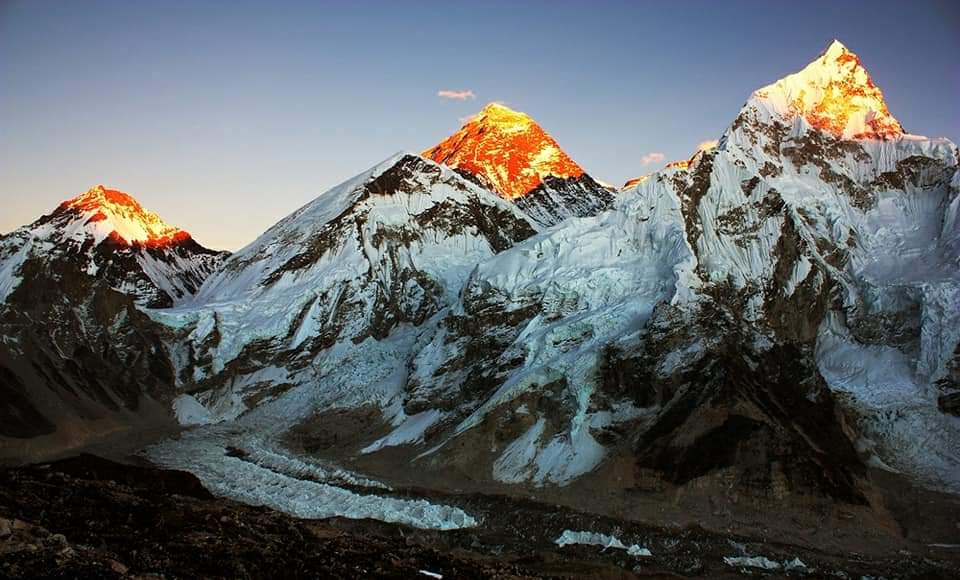Everest Base Camp Trek in the spring season:
Everest base camp trek in the spring season is an excellent highland adventure in Sagarmatha National Park, a site of global significance. The journey across the high-altitude terrain takes in the striking views of the more than 8000-meter peaks, including the summit of Everest, the highest mountain in the world.
Trekking to Everest Base Camp is a mind-blowing adventure experience filled with several wonders. With the proper hiking schedule, there is a chance to learn more about the Sherpa population and the alluring culture of the Khumbu region’s residents.
The entirety of the Everest region can now be reached by miracle by a quick Himalayan flight from Lukla, located near Kathmandu’s domestic airport. The extraordinary adventure through the historical track found by the global pioneer awaits with many restless feet.
The Everest Base Camp
The Base Camp of Everest Trek is an exceptional adventure trekking journey that takes you to Mount Everest’s base camp. The eight-thousand-meter Lhotse, Everest, and numerous other peaks, including Thamserku, Ama Dablam, and others, may be seen from this route. It is gratifying to trek with this charming peak in the Everest region. However, this walk is not just about the mountains but also beautiful because of the variety of societies and individuals it encounters.
The Everest base camp trek, which will take you past picturesque Sherpa cultural villages, glacial rivers, and stunning foliage, is unquestionably a memory of a lifetime everyone should undertake at least once. Everest is a fantastic location, and if you trek there, you’ll undoubtedly learn a lot about living vertically and take in some of the world’s most breathtaking scenery.
Furthermore, genuine tranquility and solace can be found in Pangboche and Tengboche. The Gokyo range and other tall mountains in the Everest Himalayan chain cast a shadow over the entire trail above that point. Spring ushers in a fresh start and ends Winter’s gloom. The flowers blossom this season, display stunning colors, and showcase their beauty while you hike. During this time, there are a lot of tourists and other hikers using the trail.
Nepal’s national blossom, the rhododendron or Laligurans, blooms throughout the Everest Region in the spring.
This time of year gives views of wildlife, birds, and greenery as one travels through the “Sagarmatha National Park,” a UNESCO World Heritage site. The area ceases experiencing altitude mountain sickness after pausing in the thin air.
The highest peak of the EBC hike is at Kalapatthar, 5555 meters above sea level. You will come across welcoming locals along the journey who can give you a glimpse into the distinctive Sherpa culture and way of life. Your treks via Sagarmatha National Park, one of Nepal’s geologically most affluent areas, lead to EBC. With over a dozen peaks rising above 8,000 meres, Everest encompasses the 1,148 square kilometer Sagarmatha National Park and is widely regarded as the highest point in the Himalayas.
The park is a popular destination for nature lovers because it is home to uncommon fauna and more than 120 bird species. Three of the 300 mountains in the Everest region—Everest (8,848.86m), Lhotse (8,516m), and Cho Oyu (8,188m)—are higher than 8,000 meters. The Base Camp Himalayan trekking begins in Lukla. However, it is also reachable from Jiri if you want a more protracted and ancient approach—flights from Kathmandu to Lukla last roughly 40 minutes.
Trekkers typically get Acute Mountain Sickness (AMS) while ascending beyond 2500 meters. Slowly developing symptoms, including dizziness, dehydration, or vomiting, are typical. For this region, we arrange a few days of rest along the walk so you have ample time to acclimate. You must take specific actions if you have fatigue, sleeplessness, or other unexpected symptoms.
Trekking to Everest Base Camp needs a high level of physical fitness. So, before making the expedition to Everest Base Camp, allow yourself sufficient exterior aerobic practice. Pushing yourself physically healthy is vital, but you are not required to undergo any particular training or physical fitness programs. Additionally, there are numerous instances each year where even young children and older people have completed the journey. The highest elevations that officially end the trip at 5,000 meters above sea level are Everest Base Camp and Kalapatthar.
Highlights of Everest Base Camp Trek in the Spring Season:
- Breathtaking Scenery
- Ideal Weather
- Blooming Rhododendrons
- Enthusiastic Cultural Experiences
- Wildlife Sightings
- Clear Mountain Views
- Mild Temperatures
- Crisp Air and Clean Environment
- Memorable Sunrises and Sunsets
- Renewed Connection with Nature
Everest Base Camp Trek in the spring month of March:
The best time of year to trek through Nepal is around March. When the mountain begins to experience warmer daytime and colder nighttime temperatures, it is said to be spring. The month is incredible.
The hilly side of Nepal comprising floras such as rhododendrons and oaks is more likely to bloom as well as trees receive greenery and become more lush. Although there may be some fresh snow during the trek in the first few days of March, for the most part, the days are clear and provide incredible panoramas of the Himalayas and its surroundings.
Trekking to Everest Base Camp is doable all year, but March is the best time to go. As the winter cold gradually dissipates, the dry yellow tree starts to bloom, and the woodlands resume their regular pace, making your daily walk of about five hours more enticing. The way of life of the Himalayan residents also returns to normal. The owners of the lodge and teahouse depart for their houses to accommodate their foreign guests. Therefore, there are no restrictions on where you can stay or eat.
At an elevation of more than 5500 m, hiking is relatively easy, thanks to the Winter’s melting cold. It can make you happy to stroll outside while it’s cold and dry and the sun shines.
Weather Conditions in Everest region
The weather at Everest base camp is relatively steady and neither hot nor chilly. Around you, everything begins to blossom. Meadows and beautiful pink rhododendron flowering areas blanket the mountainsides. The sky, mountains, and snow starkly contrast the lovely scarlet flowers. The feeling of hiking through rhododendron blossoms is simply spectacular.
Bird sounds and smells are all around. The unobstructed views of Ama Dablam, Lhotse, and Nuptse will delight your eyes. Unique natural vegetation exists. The surrounding summits and their most breathtaking vistas are shown. Cities celebrate a considerable number of colorful festivals and holidays. When the weather is pleasant, and the sky is clear, walking is easy and delightful.
Khumbu Valley is nice and sunny in March, but it could get chilly if Winter tightens its hold. Days have a more transparent sky, allowing hikers to take in the grandeur of lush valleys, snow-capped mountain peaks, and rugged cliffs. It doesn’t get very windy or stormy in March. The weather is much more predictable, milder, and has terrific sunny days at this period of year. Since they frequently occur, travelers must be prepared for the chillier evenings.
It’s still relatively early in the spring, so it’s excellent on the initial day of the month. However, by mid-March, the weather begins to get better. The typical daily high in March is about 15 degrees Celsius, but the overnight minimum is substantially lower. In the evenings, the air tends to be colder and crisper. The temperature falls to a frigid 0 degrees Celsius at night. Despite the impacts of Winter, there is no fog in March, and the blue skies are almost unmistakable. As a result, hikers may see the adjacent mountains with ease.
Everest Base Camp Trekking in April:
The Everest Base Camp route is best in April, the second-greatest month of the blossoming period. The weather in April is warm in the lower heights and more moderate-higher up. The enthusiasts enjoy trekking in the month of April, especially many trekkers who plan to scale a peak during this period. However, April is often suitable for Everest trekking and mountain climbing.
The moment has come for you to experience and indulge yourself in a trek to Everest Base Camp if you share a passion for travel and want to hike up Mount Everest. In April, the weather in the Everest region is perfect for trekking. Although April in Kathmandu can be awkward, conditions in the mountains are still more extraordinary: Namche Bazaar, a crucial halt on the Everest Base Camp (EBC) trek, averages 1°C to 11°C in April. Higher heights will see cooler temperatures.
Additionally, April has very little likelihood of rain. The mountains may get considerably obscured further into the month when the humidity rises. Although the skies aren’t as straightforward as in the winter months of March and April, the pleasant temperature-to-clarity mix is on your side.
Trekkers have taken notice of the beautiful weather since April is an active time on the Everest trail. This season, lodging on the usual EBC route fills up rapidly. Wind speed should also be considered because it could make people feel cold. You’ll chill in the swiftly dry, cool breezes.
Your overwhelming cold will hardly be affected by the slow-moving sensations. To avoid the frigid wind, it is advised that you begin your walk early.
Everest Region Trekking in May:
You would want to take advantage of so many by not traveling to the Everest region in May, as it is the final month of this magnificent Nepali spring. Your trekking trip in May will be enhanced by the numerous other travelers you’ll encounter.
Your flights will be excellent, which is another thing you can count on while climbing to the Everest region in May. You can witness the peaks of the Himalayas in all their splendor as you travel to Lukla. The vista is equally as impressive if you take a helicopter excursion from Namche Bazaar to Base Camp or Kalapatthar. So it would be best if you didn’t worry whether you plan to go trekking, on a helicopter or heli tour.
The month of May is the Best Time of the Year for Trekking In the Everest Region
The month of May marks the changeover from spring to summer. So, if you go to Everest in May, you can encounter a mix of Spring and Summer. The weather will be much hotter if you go on a trek around the end of May. Crisp and generally stable weather is present. The sunrise and sunset vistas of enormous mountains will be seen in the clear skies.
May is the best time of year for trekking to Everest Base Camp or going on any other adventure trek in the Nepal Himalayas. The weather in this month is glamorous and we can observe awe-inspiring vistas of the Himalayas. The ideal month for a memorable and enjoyable trekking experience of a lifetime is when you are indulging yourself in the Everest base camp trek. As May is considere the start of the monsoon season, the visibility might be more complex than in mid-May. Additionally, it may have an impact on planes to and from Lukla. The days are sunny and beautiful. While afternoons can become foggy, mornings are usually clear.
There is less of a chance that it will snow. Early May is drier in the Everest region. While ascending at the very end of May, there is a potential for brief showers. May is the entry month for the monsoon season. There is a possibility of changing weather conditions. The grandeur of the surrounding landscapes is enhanced by the beautiful skies in May. It’s easy to see the mountains in the distance. May is the ideal month to view the sugar-coated mountain summits.
Early May
Early May daytime highs are typically in the range of 13 degrees. This is a pleasant temperature for a day walk. At night, the temperature can go as low as 1 degree. For the nights, invest in comfortable sleeping bags and down jackets.
Moreover, the Everest base camp Trek in the Spring season is an achievement to treasure, made much more so by the breathtaking scenery and pleasant weather. It’s a journey that fosters amazement, thankfulness, and personal development, comparable to reaching one’s full potential while living in harmony with the breathtaking beauty of nature.
You are given an unfiltered, unadulterate connection to the natural world as you breathe in the pure air and take in the purity of this setting, reminding you of the profound treasures that await those who dare to investigate. The Everest region transforms into a place of transcendence in the spring, a haven of beauty and rejuvenation where you can feel the beat of the Earth itself in your steps.




